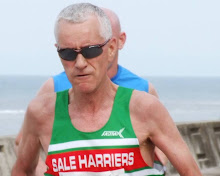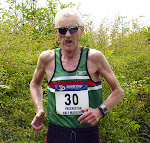He was impressed by my 5 X 1K session earlier that day: saying that a session such as 1 x 600, 2 x 300, 4 x150 would be the most his group would do. 1800 metres in total. But at 95% effort; making it a real "speed endurance" session.
Note this runner sunbathing between reps. Easy life!!!
I mentioned a 10 X 1K session I'd done some years back on a dark , cold , wet night when I looked up to the heavens and literally shouted out, "What have I done to deserve this". There was no one else on the track at the time, fortunately.
He said that his group of sprinters can often have up to 6 minutes recovery between reps, doing them either on an indoor track in winter or certainly going inside to recover. I presumed the recovery would entail the use of heart monitors but he said not.
There were 2 main coaching set ups at Sale in the '60s. Both extremely successful but as headed by completely different individuals. My coach, Alan Robertshaw, was a runner himself. He didn't run every session with his groups but he could. Alan joined Sale Harriers in 1954 and had a major role in transforming the club from a small male based club to possibly the largest club in the country for both sexes of all ages with a national if not international reputation. The number of athletes he has nurtured to the highest levels is hundredfold and would take a whole book to write about. I don't recall particularly any sessions with recoveries being monitored by lowering pulse rates.
In contrast, coach Eddie Powell headed up another group which as Alan's likewise included several national junior champions. He described himself as, "nearly 58, about 15 stones, glasses, bald, a heavy smoker who does not possess a tracksuit. I have never run a yard with them (his group of athletes) but have travelled thousand of miles, been frozen and soaked many, many times and enjoyed every minute of it".
He went on to say that he was present at every session they undertook on the track and all their work was done with the pulse rate being taken regularly. He would certainly have appreciated the heart rate monitors we have now back in '60s and it's perhaps surprising that a coach today, certainly of sprinters, doesn't make use of such technology.
Comparing Alan Robertshaw and Eddie Powell, it begs the question as to what makes "the perfect coach" and the use of the different types of knowledge they possess. But that's another blog for another time, I think.......
The Friday tour of the Fewston/ Swinsty res went quite well with a fairly rare sub 60 minute clocking . But I must confess I did have to push it quite hard up the last hill to the finish. All good stuff, none the less.











No comments:
Post a Comment